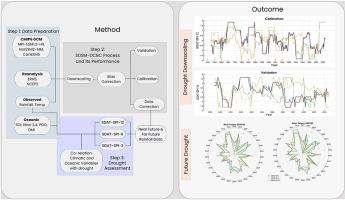Drought prediction in Bangladesh under changing climate: Integrating SDAT-SPI and SDSM-DCBC with CMIP6 data
IF 5.6
Q1 ENVIRONMENTAL SCIENCES
引用次数: 0
Abstract
Drought is a recurring environmental challenge that disrupts soil moisture and crop water balance due to prolonged dry spells. In Bangladesh and many other regions, it has emerged as an increasingly urgent natural hazard. This study employed rainfall data to develop statistically robust drought indicators using SDAT-SPI, a nonparametric tool. Additionally, CMIP6 datasets were analyzed to assess future drought trends under various climate scenarios, providing deeper insights into potential climatic changes. To further bridge the gap between global climate models and localized drought impacts, a novel drought downscaling and bias correction framework namely SDSM-DCBC approach for CMIP6 data was developed. The SDSM-DCBC approach was applied to improve the accuracy of drought assessments by comparing model simulations with observed data. Results indicate extended drought spells in certain years, with pronounced drought clusters projected for 2052–2053 and 2082–2083. Correlation analysis revealed a statistically significant relationships between global oceanic indices and regional drought. The Niño 3.4 index was identified as the primary driver of long-term drought in the Southern region, while the Pacific Decadal Oscillation (PDO) exerted the strongest unique influence in the North. These findings enhance drought prediction accuracy and provide an essential tool for developing effective, region-specific adaptation strategies.

气候变化下孟加拉国干旱预测:SDAT-SPI和SDSM-DCBC与CMIP6数据的整合
干旱是一种反复出现的环境挑战,由于长期干旱,它破坏了土壤水分和作物水分平衡。在孟加拉国和许多其他地区,它已成为一种日益紧迫的自然灾害。本研究利用降雨数据,利用非参数工具SDAT-SPI开发统计稳健的干旱指标。此外,对CMIP6数据集进行分析,以评估不同气候情景下的未来干旱趋势,为潜在的气候变化提供更深入的见解。为了进一步弥合全球气候模式与局部干旱影响之间的差距,提出了一种新的干旱降尺度和偏差校正框架,即SDSM-DCBC方法。采用SDSM-DCBC方法,通过模型模拟与观测数据的比较,提高了干旱评估的准确性。结果表明,某些年份的干旱期延长,预计2052-2053年和2082-2083年将出现明显的干旱集群。相关分析表明,全球海洋指数与区域干旱之间存在显著的相关关系。Niño 3.4指数是南方地区长期干旱的主要驱动因素,而太平洋年代际涛动(PDO)对北方地区的独特影响最强。这些发现提高了干旱预测的准确性,并为制定有效的区域适应战略提供了重要工具。
本文章由计算机程序翻译,如有差异,请以英文原文为准。
求助全文
约1分钟内获得全文
求助全文
来源期刊

Environmental and Sustainability Indicators
Environmental Science-Environmental Science (miscellaneous)
CiteScore
7.80
自引率
2.30%
发文量
49
审稿时长
57 days
 求助内容:
求助内容: 应助结果提醒方式:
应助结果提醒方式:


